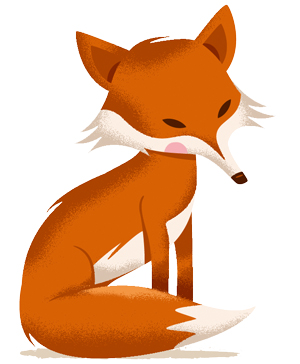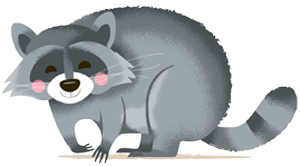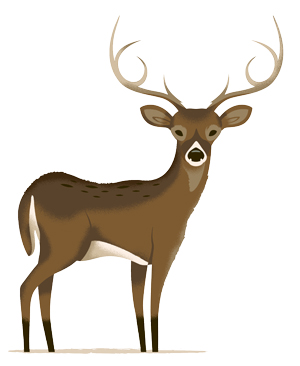If you think the local raccoons are fiendishly clever, managing to eat garden tomatoes on the exact day they ripen, or that squirrels display an uncanny knack for squeezing into microscopic holes in attic siding, prepare to meet a new neighbor with special abilities: the coyote.
Originally common to the Great Plains, coyotes have been moving east for a century. “They’ve probably been here for a decade, in small numbers, and we’ve never had one hit by a car,” says Greg Zell, a natural resources specialist for Arlington County. “That gives you an idea of how smart they really are, and how cautious.”
The coyote might make the perfect poster child for our uneasy relationship with local wildlife, except that it’s taken 10 years to get this cunning relative newcomer to pose for a photo. It wasn’t until April 2012 that a motion-triggered camera in Potomac Overlook Regional Park finally caught a coyote on video.
Although Erik Oberg, a biologist with the George Washington Memorial Parkway, has yet to spot his first coyote in Northern Virginia, he got to know the animals well while working at Joshua Tree National Park in California. There, he says, coyotes actually learned to fake injuries while standing at the side of the road, limping or holding up a paw to collect handouts from sympathetic visitors. “Then, as soon as the National Park Service vehicle with the big green stripe pulls up, the coyote was immediately able to recognize the park vehicle, and ran off without any injury at all.”

Most people think of Arlington as an urban area, but the coyotes are a reminder that it’s also a living ecosystem, even though only 4.4 percent of the county today consists of natural, undeveloped land. In 2005, county officials made an unusual decision that launched Zell on what he describes as “a giant scavenger hunt.” Arlington County decided to survey its parks and streams to find out what, exactly, lives here.
The answer, it turns out, is quite a lot. In three years of searching, Zell and his fellow biologists found 7,600 different species of native plants. They also spotted nearly 200 species of birds, including three types of owls; seven species of turtles; and six species of salamanders. The biologists counted 28 kinds of dragonflies, including the fetchingly named Slaty Skimmer and Unicorn Clubtail. Bats, beavers, muskrats and an abundance of Kirtland’s short-tailed shrew were all checked off on the list. The rarest animals were documented only as roadkill, including a river otter found on Route 66 near the East Falls Church Metro Station and a bobcat that met its demise on Chain Bridge Road in McLean. The hours of searching did not yield a single skunk.
Despite this seeming abundance of life, the place we call home has been radically altered by humans ever since the 1700s, when colonial settlements replaced the villages of Algonquian-speaking people. Some animals have adapted to the proliferation of development, while others have not, producing a divide between the losers and the winners.
The losers include animals like the rare queen snake, which specializes in eating molting crayfish and needs woodland streams to survive. The winners, not surprisingly, are animals that behave quite a bit like people—flexible generalists who are open to eating anything and living anywhere. Raccoons, deer and foxes all fit neatly into this category.
Although not all foxes have fared equally. When the first colonists arrived in Virginia, only gray foxes inhabited the area. Gray foxes still live here today, but their numbers have dwindled because red foxes are larger and hard to compete with. Unlike reds, gray foxes are known to climb trees, and can be identified by the black tips on their tails.

Where did our red foxes come from? Some historians believe they’re the descendants of animals imported by the British and released for foxhunting. Today, these familiar creatures display a casual attitude toward living around people. They often find garden sheds to be convenient places to dig a den and raise a family.
Of course not all local (human) residents are thrilled to have such neighbors. Some find it unnerving to discover a wild animal bedding down in their backyard, especially after hearing tales—however few and far between—of animals posing a threat to humans, such as two rabid beavers that were spotted and killed in Fairfax County last September. In one nightmarish incident, an elderly woman was bitten by a 35-pound beaver while swimming in Lake Barcroft and didn’t escape until a bystander beat the animal off with a canoe paddle.
Foxes can also carry rabies, although attacks by rabid foxes remain fairly rare (the last one in Arlington occurred in 2008, according to the Animal Welfare League of Arlington). Some people fear that foxes will kill their cats, but this is largely a myth. “Adult cats are a bit too big and dangerous for a fox to handle,” explains Alonso Abugattas, a natural resources manager for Arlington County. An average red fox weighs about 12 pounds—less than a well-fed tomcat, which comes equipped with its own set of teeth and claws.

Like foxes, raccoons are classified as “locally overabundant” in the 2008 “Wildlife of Arlington” report prepared by the county. And if you’ve ever witnessed an acrobatic raccoon shimmying up a drainpipe, you might agree with Virginia explorer William Strachey, who wrote in 1612, “the Rockoone I take to be a species of monkey.”
These animals are so adaptable, in fact, that Zell has witnessed a change in their behavior during his tenure as a local park ranger.
“When I started working for Arlington County about 30 years ago,” he says, “the rule was that if you saw a raccoon out during the day, that animal could be sick or rabid. In the last decade, it’s become perfectly normal to see raccoons out during the day. That’s just an example of one of our smart urban animals adapting their lifestyle to match ours.”
It’s hard to overestimate the intelligence, or the resourcefulness, of a raccoon. Donna Ward, who operates Ward Pest Control in Arlington with her husband, Jim, received a call last year from distraught homeowners who had laid sod in their front yard. While the grass looked perfect at nightfall, the next morning, several strips of lawn had been neatly rolled up into large balls. It looked like the work of pranksters, but the pranksters in this case were nocturnal and furry. (Raccoons have discovered that bare earth prepared for sodding is a wonderful place to hunt for grubs and insects, and sometimes roll back sod to expose the ground again. A natural repellent usually breaks this nightly routine.)
Nesting is another instinct that occasionally causes friction between raccoons and people. Raccoons normally den in hollow trees, but with dead trees becoming increasingly scarce, some animals are searching out alternatives, such as chimneys.
Glencarlyn resident Sheridan Swope discovered this firsthand when she followed a trail of ashy footprints, Sherlock Holmes-style, from her fireplace to her kitchen counter, where she found that several raccoon kits had busted open the trail mix. Animal-control officers collected the small bandits, but because most wild animals can’t be relocated under Virginia law, the raccoons were simply moved outside.
“If a raccoon gets in someone’s house, we do trap and release in the same area,” explains Susan Sherman of the Animal Welfare League of Arlington. “So we educate people on how it got in. Raccoons will go in attics and chimneys if they can, which is why we recommend people cap their chimneys.”
Still, the animal causing the most local agita is probably the deer. As many homeowners will attest, deer love suburban environments, enthusiastically grazing on the mowed lawns, expensive shrubs and garden plants that mimic their favorite meadows. They also appreciate readily available water sources. Richard Peabody, who lives near Washington-Lee High School, has seen numerous deer jump a four-foot fence to sip from his backyard kiddie pool.

The deer’s natural predators along the East Coast were driven out centuries ago, but oddly enough Arlington residents in 1925 weren’t plagued by deer munching in their gardens. At that point the animals had been hunted virtually into extinction throughout Virginia. Deer from other states were reintroduced between 1930 and 1950 to provide sport for hunters and food for dinner tables.
Now that most humans have switched from foraging in the woods to shopping at the supermarket, however, deer populations have exploded, unchecked. Today, “we’ve sort of created almost the perfect storm, from a habitat perspective, for deer,” Zell says.
That’s why Oberg recruits volunteers every November to help with a local deer-density survey. His line: “If you’ve never ridden in the back of a pickup truck shooting deer with laser beams, you don’t know what fun is!”
The volunteers gather at dusk in Great Falls Park, bundled up for their open-air ride among the leafless trees, and shine spotlights on every deer the truck passes. Then they count the animals and, in a version of deer laser tag, use a range finder to determine the animals’ distance. In recent years, the number of deer in the park has fluctuated from 85 to 116 per square mile—far above the 15 to 20 per square mile that’s considered healthy for the forest.
“Some parts of Fairfax County literally have so many deer that the forest is no longer regenerating,” Zell says. “You can no longer see new saplings coming up, because they’re eaten so quickly.”
A single deer can eat five pounds of plants per day, preferring native species like strawberry bush, trilliums and orchids. The result is less habitat and food for other indigenous mammals and birds.
It’s difficult for local officials to know exactly how many deer live in Arlington (the census conducted in Great Falls Park is considered the best available benchmark for our area), although statistics collected by the Animal Welfare League of Arlington (AWLA) suggest that the deer population is on the rise here, just as it is in adjacent counties. The number of callers to AWLA reporting deer trouble rose steadily from 39 in 2005 to 79 in 2011.
As Arlington County officials make plans to count deer, neighboring Fairfax County has been actively reducing its herd since 1997, when a local librarian heading to work one morning was killed in a collision with a deer. Just over 900 deer were culled in 2012, using a variety of methods. In McLean’s Marie Butler Leven Preserve, police sharpshooters hunted deer in the 20-acre park during the night. Scott’s Run Nature Preserve, which is also in McLean, has been the site of managed hunts with both shotguns and archery.
Some local residents have questioned whether archery is a humane method of reducing the deer population, but according to Charles Smith of the Fairfax County Park Authority, “our wounding rate for archery is equivalent to that of sharpshooting. Less than 4 percent of the wounded deer are not recovered.” To qualify for the program, archers must pass a skills test, record every arrow they shoot, and use arrows marked with a personal code, so that each hunter’s actions can be tracked.
“Ultimately, our goal isn’t to kill deer, it’s to manage the ecosystem,” says Smith. He points out that over-browsing by deer is shifting the region’s oak and hickory forests, which support high biodiversity, to beech and maple forests, which aren’t as good at supporting wildlife. “Oak-hickory forests can support up to 500 species of moths and butterflies,” he explains. “And 90 percent of migrating birds rely on those caterpillars for food.” Reversing the effects of deer over-browsing could ultimately benefit hundreds of species.
Will coyotes have any impact on the deer population? Not likely, according to local experts. Like our area’s Big Three (deer, raccoons and foxes), coyotes are adaptable and skilled at survival. But in their case, that means feeding on an eclectic menu of acorns, berries, insects, dead things, and small animals such as mice, frogs, rabbits and birds. An adult deer is far too large for them to handle, although cats and miniature dogs are well within a coyote’s hunting wheelhouse—another reason to leash dogs and keep cats indoors.
A few years ago, Chip Beck, who lives in Tara-Leeway Heights, discovered that his dogs can detect coyotes. “At around [2 a.m.], our three Chihuahuas went berserk in their pen in the interior of our house,” he says. “When I looked out the window of our bedroom, I saw a scrawny but sizable coyote ambling down the middle of Greenbrier Street.”
Last June, after another night of intense barking, Beck’s wife, Kathy, discovered the remains of their family cat in a neighbor’s yard. She saw coyotes sauntering down the street the next three nights, and suspects they were to blame.
But aside from inflicting the trauma of losing a pet, coyotes don’t pose much of a threat to people. “I did a lot of work [in an area] where coyotes are well established,” Oberg says, referencing his stint in California. “We got a million visitors a year, and we did not have problems with coyotes chasing down toddlers in campgrounds. We did get the occasional bite, [but that was] from people trying to hand-feed coyotes.”
Having hidden from public view for a decade, Arlington’s coyotes are likely to remain secretive, building their dens in steep ravines or stream valleys near the Potomac. They’re also likely to remain silent, unlike the coyotes out West that fill the night with their eerie yips and howls. “Maybe they’ve realized that vocalization is not a good idea for them here, from a survival perspective,” muses Zell. “Maybe they’re that smart.”
Virginia’s present-day ecosystem certainly is not the same one that existed in 1607, when John Smith stepped off the boat to find a region where mountain lions and gray wolves roamed with buffalo and elk. And yet, there are still treasures to be found in our forests and parklands. Arlington County is located along a climatic dividing line where northern species like lilacs and southern species like magnolia intermingle. This plant diversity feeds animal diversity. For example, scientists have documented 754 species of beetles alone along the George Washington Parkway, and that number is expected to surpass a thousand with further research.
In many ways, Zell says, the most surprising thing about our region’s plants and animals is that many have survived so resourcefully—“especially in the nooks and crannies that we haven’t developed.”
Or, in some cases, in nooks and crannies that are manmade. In 2011, Julie Gosselin and her husband bought a fixer-upper near Marymount University and converted its lower level into a rental apartment. They drained the derelict swimming pool choked with lily pads and attached a cover, but rainwater soon began collecting on its loose surface. That spring, an odd noise in the backyard mutated within days to a deafening roar. It was the sound of a hundred frogs that had apparently been using the old swimming pool as a love nest for years, calling out for mates.
“We already knew we had bought the money pit,” Gosselin says, “but we weren’t expecting a biblical plague.”
When the tenants complained that they couldn’t sleep, Gosselin knew the frogs had to go. But first, she called the local nature center for advice. A staff member collected tadpoles and eggs from atop the pool cover and took them to the pond at Long Branch Nature Center. The noisy lovebirds turned out to be Cope’s gray tree frogs, which were known to live in only three other places in Arlington. It won’t be clear if the relocation worked until late this spring when the frogs start advertising for mates, but Gosselin is keeping her fingers crossed that the peepers thrive in their new home.
Despite the occasional clash over squatting rights, these days humans and animals are finding ways to coexist peacefully in the areas due west of the Potomac. While the good citizens of Arlington, Falls Church and McLean are tucked up in their beds this spring, a nearby coyote might be teaching her puppies how to hunt mice. A great horned owl could be flitting silently through the trees, yellow eyes searching for the gleam of a vole.
And if it’s May or June, a Cope’s gray tree frog might be broadcasting its personal ad into the night air. “Single gray male, interested in saving our species,” it might begin.
Laurie McClellan is a writer and photographer who lives in Arlington.
